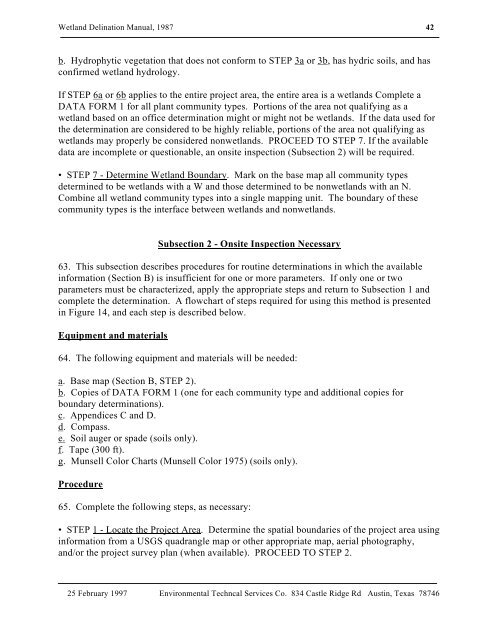1987 Wetland Delineation Manual - The Wetlands Regulation Center
1987 Wetland Delineation Manual - The Wetlands Regulation Center
1987 Wetland Delineation Manual - The Wetlands Regulation Center
You also want an ePaper? Increase the reach of your titles
YUMPU automatically turns print PDFs into web optimized ePapers that Google loves.
<strong>Wetland</strong> Delination <strong>Manual</strong>, <strong>1987</strong> 42<br />
b. Hydrophytic vegetation that does not conform to STEP 3a or 3b, has hydric soils, and has<br />
confirmed wetland hydrology.<br />
If STEP 6a or 6b applies to the entire project area, the entire area is a wetlands Complete a<br />
DATA FORM 1 for all plant community types. Portions of the area not qualifying as a<br />
wetland based on an office determination might or might not be wetlands. If the data used for<br />
the determination are considered to be highly reliable, portions of the area not qualifying as<br />
wetlands may properly be considered nonwetlands. PROCEED TO STEP 7. If the available<br />
data are incomplete or questionable, an onsite inspection (Subsection 2) will be required.<br />
• STEP 7 - Determine <strong>Wetland</strong> Boundary. Mark on the base map all community types<br />
determined to be wetlands with a W and those determined to be nonwetlands with an N.<br />
Combine all wetland community types into a single mapping unit. <strong>The</strong> boundary of these<br />
community types is the interface between wetlands and nonwetlands.<br />
Subsection 2 - Onsite Inspection Necessary<br />
63. This subsection describes procedures for routine determinations in which the available<br />
information (Section B) is insufficient for one or more parameters. If only one or two<br />
parameters must be characterized, apply the appropriate steps and return to Subsection 1 and<br />
complete the determination. A flowchart of steps required for using this method is presented<br />
in Figure 14, and each step is described below.<br />
Equipment and materials<br />
64. <strong>The</strong> following equipment and materials will be needed:<br />
a. Base map (Section B, STEP 2).<br />
b. Copies of DATA FORM 1 (one for each community type and additional copies for<br />
boundary determinations).<br />
c. Appendices C and D.<br />
d. Compass.<br />
e. Soil auger or spade (soils only).<br />
f. Tape (300 ft).<br />
g. Munsell Color Charts (Munsell Color 1975) (soils only).<br />
Procedure<br />
65. Complete the following steps, as necessary:<br />
• STEP 1 - Locate the Project Area. Determine the spatial boundaries of the project area using<br />
information from a USGS quadrangle map or other appropriate map, aerial photography,<br />
and/or the project survey plan (when available). PROCEED TO STEP 2.<br />
25 February 1997 Environmental Techncal Services Co. 834 Castle Ridge Rd Austin, Texas 78746


